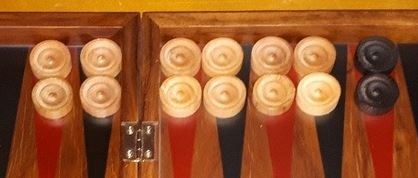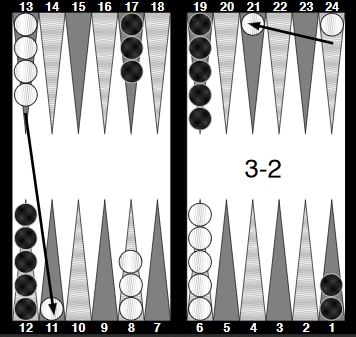Last updated on May 27, 2024
This Deluxe Backgammon post is another in our series for beginners and newcomers. Today we are going to take a look at the concept of slotting in backgammon.
What is slotting?
In order to protect your checkers from hits from your opponent, you have to secure points. To make a point on the board, all you have to do is to put at least two checkers on it. Once you have at least two checkers on a point on the board your checkers cannot be hit. Additionally, you now own that point as long as your checkers stay there. This means your opponent cannot land on the point, which creates an obstacle for their movement.
A string of adjacent points is known as a prime. A six-point prime creates a barrier that cannot be breached. Slotting involves moving a single checker to a vacant point with the intention of securing it with another checker on a subsequent roll. Slotting is a risky backgammon tactic. However, it is the fastest way to secure points on the board. There are times when slotting is quite safe. For example, when your opponent has checkers on the bar or when the point you slot is at a safe distance from any attack. The key is to know when to, and when not to, slot.
When to slot
Sometimes you are forced to slot. That is when your roll leaves you no choice but to expose a checker to direct attack. If this happens, you will have two approaches to consider, attack and defence. To attack, slot the point that will result in the most constructive position should you not be hit. If that isn’t possible, slot the point that will do you the least harm if you should be hit. To defend, use your knowledge of probability to slot the point least likely to be hit.
When your opponent has blots exposed in their home board, it’s often a good tactic to take the chance and slot. If the opponent hits you, their blots would be exposed to attack from your checker re-entering. As a result, if you hit in reply, they will lose a lot of ground in the race. If you don’t get hit, you will have the opportunity, on subsequent rolls, to secure your slotted point.
At the start of play, the 6 and 13-points are heavily stacked with five checkers each. These excess checkers are effectively out of play and it is a good idea to move them into more constructive positions by slotting. For example, with the opening rolls (5-1, 4-1, 2-1), the 1 can be slotted to the 5-point. This does involve some risk, as you can and will be hit with any roll of 4. However, this play affords considerable advantage if you succeed in securing the point on the following roll.
Slotting can be used to make an important point that you would have trouble making otherwise. For example, if you are trying to build a six-prime, but have gaps in your wall, slotting is often the most efficient way of securing the missing points. Like all slotting decisions, this is not without its risks, however, a short-term risk can often lead to a stronger long-term position.
When not to slot
Don’t take unnecessary risks. If you have a number of builders converging on an important point there is no need to add additional risk by slotting. Use the existing material to secure the point. Slotting just adds an element of risk by leaving an unnecessary blot exposed.
If your opponent has split their back checkers be careful of slotting, particularly the 5-point or the bar-point. This would leave your checker at risk from a double direct hit (6 or less). In this situation, there is too much ground to be lost if your blot is hit. Likewise, if you have split your back checkers, slotting is generally a bad move, as it would leave three or more blots on the board. Taking risks is important, particularly early in the game, but there should be a limit to the level of exposure you are willing to take.
Other factors
There are other factors that determine when, and when not, to slot. These are based on the specifics of each position. Consider these questions before you decide on slotting:
How strong is your opponent’s inner board? If they have a strong board, slotting becomes very risky, as a subsequent hit means you might struggle to re-enter from the bar. If their home board is weak, slotting becomes a much better option. Alternatively, if you have an anchor in your opponent’s home board, slotting becomes far less risky, as you have a point of re-entry if hit.
How strong is your own home board? If you have a strong position in your own home board it allows you to play more aggressively, particularly if the opponent’s back checkers are trapped. Slotting can provide the opportunity to close gaps and secure a stronger prime. Slotting nearly always incurs risk, so even if your home board is strong the decision to slot must take into account the opponent’s home board strength. For example, it wouldn’t matter how strong your home board was if your opponent had a closed home board. In that instance, it wouldn’t be worth the risk of slotting. It would be far better to wait until your opponent has lost their timing.
Do you need to buy time? There are occasions when you need to buy time or need to get checkers back into your opponent’s home board so that you can hit. It may be that your opponent has a strong lead in the race and you are close to breaking contact. Providing there are still places to re-enter, in this instance, it is worth considering slotting to leave some blots as bait. If your opponent hits your checker and sends it back to the bar, providing you can re-enter, you will now be well placed to hit incoming blots. This is often referred to as recycling. It gives increased opportunities to hit and buys time.
Related content
Backgammon Galore Slot definition.




Slotting in backgammon seems like an aggressive and risky move. I understand that you want to secure the point on your next move, but it seems so dangerous to leave a single checker on its own. Does this backgammon tactic actually work? Lots of great backgammon material on this site, keep it coming, thanks Giuseppe
Hi Giuseppe, slotting in backgammon is a calculated risk. There is a chance that you will get hit. However, if you take the chance early in the game you have time to re-enter your checker and recover. If the slotting move pays off and you secure the desired point, you gain a significant strategic advantage. Experiment with slotting and take note of the results. Thanks for taking the time to visit Deluxe Backgammon, Jason
I have played backgammon socially for many years, but never considered the concept of slotting. Even if I did, I would have considered leaving a blot to be too risky. This article explains the concept well and I have started to apply the tactic to my games. I am actually starting to see positive results! My backgammon has definitely improved since reading this article. Thanks!
Hi! a friend shared this backgammon blog with me, so I came to look it over. Its amazing and a great help for a beginner at backgammon. I had never really considered the concept of slotting before. It seems risky, but certainly has its benefits. Overall, this is a great backgammon website. I am slowly working through the Deluxe Backgammon playing guides. Any tips on how to improve my backgammon quickly? Thanks, Stu.
Hi Stuart, we can help. start with the backgammon playing guides and read through the basic articles. Then, read the post on how to improve your backgammon. Next, return to the backgammon playing guides and read the posts for beginners and intermediates. Remember to practice backgammon in real life, online or against backgammon software. Concentrate, learn, apply and your backgammon will improve. Thanks for for commenting at Deluxe Backgammon, Jason
Is slotting an aggressive or foolish tactic? It seems strange to leave a checker ready to be hit.
Hi Myna, in backgammon, slotting is a calculated risk. Yes, there is the chance the lone checker will be hit, but you are relying on probablity. Playing too safe also has its problems, take a chance occasionally and it it will pay off. Backgammon is a game of chance, but if you play with strong strategy and tactics, the gamble will pay off. Enjoy your backgammon and thanks for taking the time to comment, Jason.